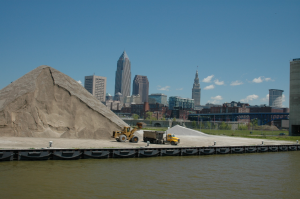It may be too cold and dreary to be in a boat for most of us just yet. But, we are not all that far away from spring and will soon be making plans to get back on the water!
And for those of us with such thoughts, we have some really good news. The United States Environmental Protection Agency recently approved the removal of “Degradation of Aesthetics” from the list of Beneficial Use Impairments (BUIs) in the Cuyahoga River Area of Concern (AOC). This action acknowledges that aesthetics have improved dramatically in the decades since the Cuyahoga and nearby Lake Erie tributaries were named one of the 27 federally-designated U.S. waterways that have experienced severe environmental degradation. The aesthetics BUI was one of 10 specific problems identified for the Cuyahoga and its watershed in accordance with the 1987 Great Lakes Water Quality Agreement (GLWQA) – a bi-national accord between the United States and Canada focused on cleaning up the most polluted tributaries draining into the Great Lakes.
In a letter to Ohio Environmental Protection Agency Director Craig Butler, Great Lakes National Program Director Tinka Hyde said, “Removal of this BUI will benefit not only the people who live and work in the Cuyahoga River AOC, but all the residents of Ohio and the Great Lakes basin as well,” and congratulated Ohio EPA staff and “the many federal, state, and local partners who have worked so hard and been instrumental in achieving this important environmental improvement.”

Environmental improvement has been dramatic in the Cuyahoga River Area of Concern.
Surveys and observations over the past few years have shown that persistent “occurrences of sludge, oil, scum or other objectionable materials that produce color, odor or other nuisances,” which are the measure of aesthetic quality set forth in a Remedial Action Plan (RAP) completed for the Cuyahoga, are now either nonexistent in the Area of Concern or are being remediated by long term control plans to reduce combined sewer overflows. Litter and woody debris are not considered persistent impairments in this category.
“This is a significant step forward on the path to delisting the Cuyahoga. It’s great to know that the progress we’re making to restore the AOC can now be recognized. With lasting support from state and federal agencies, and local partners, we can see a future when we reach all our restoration goals,” said Jennifer Grieser, Chair of the Cuyahoga River AOC Advisory Committee.

Restoration along the Cuyahoga River bank.
The next BUI to be delisted – hopefully in the spring of 2018 – is “Public Access and Recreation Impairments,” which has been helped by the development of trails, rowing clubs, fishing areas, boating and paddle sport amenities, residential areas, and dining and entertainment facilities that now allows its removal and signals full recovery. All one needs to do is stroll along the east bank of The Flats in Cleveland, or take a cruise on the Cleveland Metroparks Water Taxi, to see examples of community development on shore and restoration actions along the river’s banks.
If you want to track the progress of the Cuyahoga River as more BUIs are delisted, check out the website for the AOC’s facilitating organization, Cuyahoga River Restoration and the Cuyahoga River Area of Concern Advisory Committee. There is also plenty of information on the web page of the Ohio Environmental Protection Agency (EPA), as well as that of Ohio Sea Grant, which is one of the organizations along with nonprofit community groups, businesses, government agencies, and local residents that collaborate to help guide restoration actions throughout the watershed. For more detail on the GLWQA and Cuyahoga AOC, as well as some of the restoration actions taking place, see my CD Blog post from March of 2017 titled: “We all know the Cuyahoga River caught on fire. What’s being done to clean it up?”
See you on the river!
 Scott Hardy is an Extension Educator for the Ohio Sea Grant College Program.
Scott Hardy is an Extension Educator for the Ohio Sea Grant College Program.